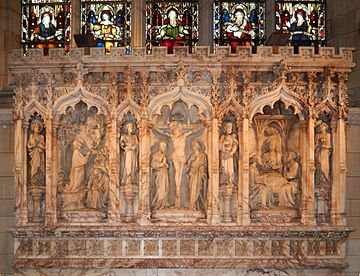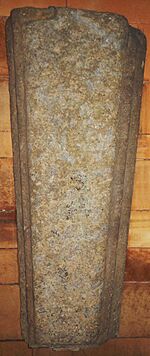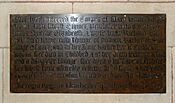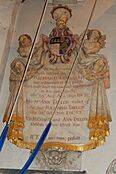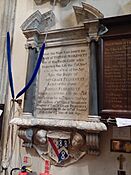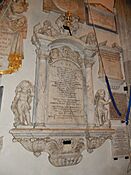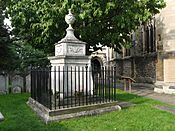St Nicholas Church, Chiswick facts for kids
Quick facts for kids St Nicholas Church, Chiswick |
|
|---|---|
| The Parish Church of Saint Nicholas | |
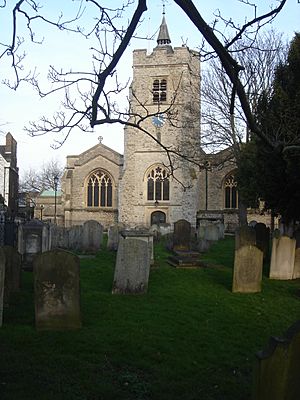
Exterior view
|
|
| region:GB 51°29′10″N 0°15′02″W / 51.4860°N 0.2506°W | |
| Location | Church Street, Chiswick, London |
| Country | England |
| Denomination | Church of England |
| History | |
| Status | Parish church |
| Architecture | |
| Functional status | Active |
| Administration | |
| Parish | St Nicholas with St Mary Magdalene, Chiswick |
| Deanery | Hounslow |
| Archdeaconry | Middlesex |
| Diocese | London |
St Nicholas Church, Chiswick is an old and important Church of England church. It is located in Church Street, Chiswick, London, very close to the River Thames. This church is considered a Grade II* listed building, which means it's a very special historical place.
The area around the church, known as Old Chiswick, grew into a village starting around the year 1181. The church's tall tower was built a long time ago, between 1416 and 1435. Most of the church building you see today was rebuilt between 1882 and 1884. A rich brewer named Henry Smith, who owned the nearby Fuller, Smith and Turner brewery, paid for most of this rebuilding.
Many old monuments and memorials are still inside the church and in its churchyard. These include memorials to famous people like the Italian poet Ugo Foscolo and the painter William Hogarth. Hogarth's monument even has a special poem written by the actor David Garrick. In the churchyard, you can also find the grave of Frederick Hitch, a brave soldier who received the Victoria Cross medal for his actions in the Battle of Rorke's Drift.
Contents
History of St Nicholas Church
There has been a church on this spot in Chiswick since at least 1181, during a time known as the Norman period. This means the church has a very long history!
In 1252, a church leader officially visited the church and made a list of everything it owned. This list included important items like a missal (a book for church services), other prayer books, a silver chalice (cup), and vestments (special clothes for priests). The list also noted that the chancel roof needed fixing.
Over the centuries, many important events happened at the church. For example, Mary Cromwell, Countess Fauconberg, who was the daughter of Oliver Cromwell, was buried here in 1713. Much later, in 1927, Major Bernard Montgomery, who became a famous Field Marshal in World War II, got married in this church.
Architecture and Design
Most of the current church building was rebuilt between 1882 and 1884. The architect who designed this new part was John Loughborough Pearson. He kept the original west tower, which was built between 1416 and 1435.
Because the tower is very close to Church Street, Pearson had to make the main part of the church (called the nave) short but wide. This makes the church almost square when you look at its floor plan. The Duke of Devonshire gave £1,000 for the rebuilding, but most of the money came from Henry Smith, the brewer.
The church is built from strong, squared pieces of Kentish ragstone (a type of stone). It has a stone top edge and a copper roof. The style of the building is called Perpendicular, which was popular in England during the late Middle Ages.
Inside the church, you can still see some parts from the 15th century. These include the tall archway that leads to the west tower and a decorative stone molding above the window over the west door.
Memorials and Monuments
St Nicholas Church has many interesting memorials, both inside the building and in the churchyard outside. These monuments tell stories of people from different times.
Inside the Church
Inside the church, you can find an old stone grave marker from 1340 with a leaf design. There are also many named memorials, including:
- Ralph Wenwood (died 1799): A wall tablet with decorative carvings.
- Charlotte Seymour, Duchess of Somerset (died 1773): A wall tablet with an urn (a vase-like container). She was married to a Duke.
- Sir Thomas Chaloner (died 1615): A grand monument with his family's coat of arms and kneeling figures of Sir Thomas and his wife.
- Mary Litcott (died 1599): A brass plaque.
- Thomas Bentley (died 1780): A monument shaped like a sarcophagus (a stone coffin). Bentley was a business partner of the famous potter Josiah Wedgwood.
- Richard Taylor (died 1698) and Richard Tayler (died 1716): Both have detailed monuments with angels and symbolic figures.
- Charles Holland (died 1769): An actor with a bust (a sculpture of his head and shoulders) on a tall stone pillar. The famous actor David Garrick wrote a special poem for his memorial.
- James Howard (died 1669): A monument with a flaming urn.
- Thomas Plucknett (died 1721) and John Taylor (died 1729): Both have monuments with decorative tops and family symbols.
- Thomas Tomkins (died 1816): A tablet with a portrait medallion.
- Charles Barnevett (died 1695) and John Beckwith (died 1815): Both have wall tablets.
In the Churchyard and Burial Ground
The churchyard and nearby burial ground also have many interesting monuments:
- Ugo Foscolo (died 1812): An Italian writer and patriot. His body was moved to Italy in 1871, but the Italian government added more words to his monument in Chiswick to honor him.
- Percy Harris (1876 – 1952): A politician whose monument has a special carving by Edward Bainbridge Copnall showing people rising from the dead.
- William Hogarth (died 1764): The famous painter. His tomb also has a poem written by David Garrick.
- Henry Joy (died 1893): A trumpeter who was part of the famous Charge of the Light Brigade.
- Philip James de Loutherbourg (died 1812): A landscape painter. His tomb was designed by the famous architect Sir John Soane.
- James Abbott McNeill Whistler (died 1903): A well-known artist, buried in a classical-style tomb.
- Richard Wright: A bricklayer who worked for Lord Burlington, the owner of Chiswick House.
- Frederick Hitch (died 1913): A soldier who received the Victoria Cross for his bravery at Rorke's Drift.
- Memorials, arranged by date
-
William Hogarth, 1764
-
Ugo Foscolo, 1812,
reworked 1871
See also


